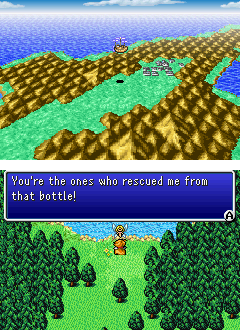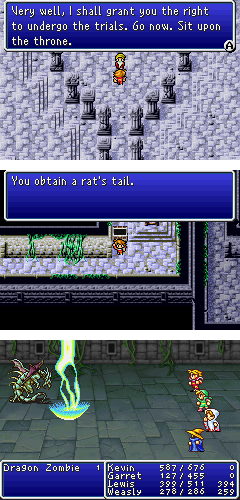 One thing I neglected to mention in my last Final Fantasy Flight entry is what an improvement the ninja class is over the thief. This guy can use all the cool weapons and armor previously limited to the warrior class, making him an much more agile version of the latter. This means the party now has two heavy hitters. With 'Haste' cast, most battles can be ended in one or two rounds.
One thing I neglected to mention in my last Final Fantasy Flight entry is what an improvement the ninja class is over the thief. This guy can use all the cool weapons and armor previously limited to the warrior class, making him an much more agile version of the latter. This means the party now has two heavy hitters. With 'Haste' cast, most battles can be ended in one or two rounds.Once you get the airship, the game becomes less linear. There's still an order of progression. For example, you can't enter the Mirage Tower without learning to decipher the Leifin language. But for the most part, you can fly and land anywhere, which gives the game more of a sandbox feel.
There are three cities in the north: Onrac, Gaia, and Leifin. Onrac is a city filled with broken pillars, which gives the impression that civilization was rebuilt over the ruins of something much greater. Gaia is a forest town that contains the best weapons, armor, and magic spells. Lastly, Leifin is hi-tech and advanced, but inaccessible because the citizens all speak gibberish.
 There was no readily available landing area near Onrac, so I had to land near the desert and walk through the forest.
There was no readily available landing area near Onrac, so I had to land near the desert and walk through the forest.Speaking with the residents revealed that the city was once part of much larger one. But a big chunk of it sunk underground when the fiend of water thrashed civilization. The city has its share of wacky denizens and sub-quest leads. For example, the party also ran into a witch who was amazed that we had legs as well as a young lady boasting about how great her legs are.
The party traveled west to get the bottled fairy from the merchant. He charged me a bunch of gil.
Flying to Gaia, the fairy automatically broke out of the bottle and flew north. We followed her to a lake where the fairy gladly drew out oxyale from the bottom. Apparently, this magical substance allows its user to breathe underwater. The rest of Gaia was filled with level 8 spells for both of my wizards, as well as weapons and armor. Unfortunately, I ran out of money. So we'll be visiting this town again after killing the next fiend.
 The party returned to Onrac and rode the barrel down into the Sunken Shrine. The first step was to travel to the very top of the shrine and meet the mermaids. They didn't mind that I stormed in and jacked their gil. Traveling northwest, the heroes acquired the Rosetta Stone. It's nice to see that the GBA translation found a more descriptive alternative than 'SLAB.' I'll have to visit Dr. Unne later to get the Rosetta Stone deciphered.
The party returned to Onrac and rode the barrel down into the Sunken Shrine. The first step was to travel to the very top of the shrine and meet the mermaids. They didn't mind that I stormed in and jacked their gil. Traveling northwest, the heroes acquired the Rosetta Stone. It's nice to see that the GBA translation found a more descriptive alternative than 'SLAB.' I'll have to visit Dr. Unne later to get the Rosetta Stone deciphered.The rest of the Sunken Shrine consisted of repetitive, blue mazes. While some of the new enemies were pretty cool, by far, the most common encounter was with groups sahagins. There were a few notable artifacts as well. The Shrine held not one, but two Light Axes, which allows the user to cast Diara. Also, I found a pair of Giant's Gloves, which casts Saber.
On the basement level, Kraken waited in his orb for the heroes to arrive. Apparently, every time you fight him, he can be either extremely difficult to defeat (endless water attacks) or extremely easy to defeat (weak physical attacks). I was lucky and met the latter. So I had Lewis cast Protera and wailed on him with a combination of physical attacks and Thundaga. The fiend fell in about 4 rounds without putting the party in any significant danger.
Three crystals restored, one to go.

 When we left off, our heroes defeated Lich, the fiend of Earth, and Marilith, the fiend of Fire. Two down, two to go.
When we left off, our heroes defeated Lich, the fiend of Earth, and Marilith, the fiend of Fire. Two down, two to go. Traveling back up the river and sailing south, the heroes used the levistone to revive the airship from the bottom of the desert. A small cutscene played, showing the sand literally splitting open and an airship (fully functional) rise up.
Traveling back up the river and sailing south, the heroes used the levistone to revive the airship from the bottom of the desert. A small cutscene played, showing the sand literally splitting open and an airship (fully functional) rise up. I recall that back in the NES version, I relied on these items quite a bit in the later parts of the game because potions were such a pain to accumulate.
I recall that back in the NES version, I relied on these items quite a bit in the later parts of the game because potions were such a pain to accumulate.